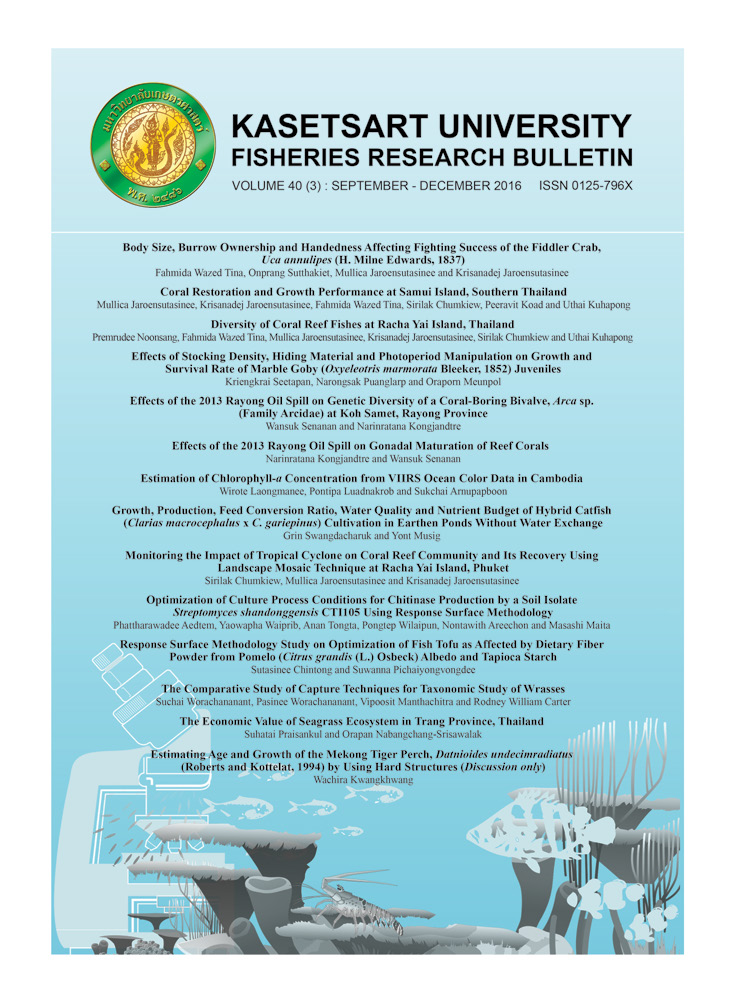The Economic Value of Seagrass Ecosystem in Trang Province, Thailand
Main Article Content
Abstract
Thailand's sea grass ecosystem expanded over an area of 18,986 hectares in 2013, making it one of the main coastal ecosystems that provide both direct and indirect benefits. The objectives of this study was to analyze the benefits derived from sea grass ecosystems in Trang, the province recognized as being rich in diversity of sea grass species and an important habitat of the iconic marine endangered species, dugongs. Three types of economic values were estimated: (1) use values from fisheries and eco-tourism; (2) indirect use values from carbon sequestration and storage functions; and (3) non-use values of sea grass ecosystem which estimated by using Choice Experiment.
Use value from fishery and tourism was estimated to be USD 1.2 M and 5 M, respectively. The only indirect use value estimated, i.e. carbon sequestration, was valued at USD 65 M. Intangible and non-traded benefits of the sea grass ecosystems amounted to USD 275 M.
These numbers will not only be useful in understanding the economic benefits, but could also help in evaluating whether the cost of conserving sea grass ecosystem would generate a net benefit. Conservation prospects are positive. On the supply side, there is recognition of the direct link between the sustainability of the sea grass ecosystem and the flow of income from fisheries. On the demand side, apart from the tourism sector, the findings from the choice Experiment Analysis also confirmed a demand for conservation measures from the general public who have neither present nor future benefits from sea grass ecosystems.
Article Details
References
2. Department of Marine and Coastal Resources. 2014. A Report of the status of marine and coastal resources: Coral reefs and sea grasses. (In Thai)
3. Department of Marine and Coastal Resources. 2013. Geoinformatics Data for Marine and Coastal Resources. DMCR. August 2013.
4. Ecosystems Market Place. 2013. Covering New Ground. The State of Forest Carbon Markets 2013. A Report by Forest Trends' Ecosystem Marketplace. November 2013.
5. Fourqurean James, W., C.M. Duarte, H. Kenedy. N. Marba, M. Holmer, M.A. Mateo, E.T., Apostolako, G.A. Kendrick, D. Krause-Jensen, K.J. McGlathery, O. Serrano. 2012. Seagrass Ecosystems as a Globally Significant Carbon Stock. Nature Geoscience. May 2012.
6. Hanley Nick, Edward B. Barbier. 2009. Pricing Nature: Cost-benefit Analysis and Environmental Policy. Edgar Elgar Publishing.
7. Kanchanapart Liewmanomond, Suchin Deetae, Wittataya Srimanokart, Hisao Ogawa. 1993. Types and distribution of seagrass beds in Thailand. Proceedings of Conference in Kasetsart University, 1993.
8. Nabangchang-Srisawalak Orapan. 2011. The Study of Impact of Public Investment on Land Use in Koh Tao Island. A Study commissioned by the Thailand Research Fund. September 2011. (in Thai).
9. Nabangchang, O. Compilation of Studies on the Economic Dimension of Coastal and Marine Resources. A report submitted to the Department of Marine and Coastal Resources. May 2011. pp. 45-49
10. Nabangchang-Srisawalak Orapan. 2012. The Study of Economic Values of Seagrass Ecosystem to Support Design of Economic Instruments for Sustainable Resources Management. A Study commissioned by the Department of Marine and Coastal Resources (DMCR). December 2012. (in Thai).
12. Liewmanomond, Kanchanapart. Suchin Deetae, Wittataya Srimanokart, Hisao Ogawa. 1993. Types and distribution of seagrass beds in Thailand Proceedings of Conference in Kasetsart University, 1993.
13. Phillips, R.C., and Menez, E.G. 1988. Seagrasses: Washington, D.C., Smithsonian Institution Press, Smithsonian Contributions to the Marine Science series, no. 34, 104p
14. Wongsurirat Manoch. 2007. A Study to support the establishment of Marine Protected Areas. Thailand Research Fund. (in Thai)
15. Serrano O. 2012. Seagrass Ecosystems as a Globally Significant Carbon Stock. Nature Geoscience. May 2012.


